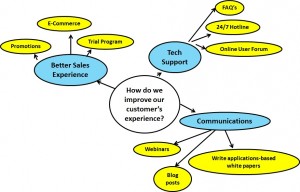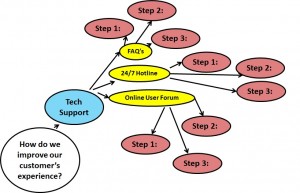Brainstorming is a little like crowdsourcing today, getting as many opinions and inputs from a group of people to solve an issue. When done poorly this turns into a creative waste if time. But if done correctly, this can be a transformative force for change resulting in not only new ideas but actionable steps toward achieving your goal.
Step 1:
Create and send an agenda that clearly states what you expect to achieve and how the meeting will be conducted to participants. The following is an example of what you should include:
Example Agenda for First Meeting:
- This meeting will be to discuss how we will … (e.g. boost sales by 20%, solve technical problem A, identify the next killer application, etc.)
- Introduction of issue – 5 min (You)
- Brainstorming session – 40 min (All)
- Identifying next steps and meeting wrap up – 15 min (You)
Note: By sending out the goal of the brainstorming session prior to the meeting, the participants will have a chance to think about this on their own prior to the meeting which improves the quality of the ideas.
Step 2:
Start the meeting by writing the identified goal on a large piece of paper or in the center of a large whiteboard or PowerPoint slide and circle it. Be sure to let everyone know that the meeting minutes will be used to begin formulating an action plan and to set priorities for any follow-up brainstorming meetings (there should be at least one more) and that the final fifteen minutes of the meeting will be used to identify actions to be taken.
Step 3:
Lead the brainstorming session by asking for major areas that need to be considered. Write these topics around the central circled goal and circle them as well. Then ask for what should be done at each of these focus areas by asking for 3 or more and for each of the sub-categories. This should be linked to each of the subcategories.
Note: Make sure that you ask someone else to take minutes for the meeting including the names of all attendees. The meeting leader should be moderating the session, updating the figure on the board/screen and keeping the team on track and on time.

Sample brainstorm meeting graphic after first meeting. Identified goal in center white circle, first level major areas in blue and second level details in yellow.
Step 4:
Take a picture of the diagrammed feedback from the brainstorming session and send this along with the meeting minutes to all participants. Ask each of them to select the top 3 subcategories that they think would have the best chance of achieving the circled goal in the center of the figure.
Note: This is a critical step since not everyone is comfortable speaking out in a group setting and this will allow you to get unbiased feedback from the quieter participants.
Step 5:
Take the top two or three highest priority sub-categories to use for a follow-up meeting to build the plan. This meeting should only include those team members that will be important to completing the goals of each of the sub-categories identified from the first meeting.
This meeting will start with a slide with a subcategory on the top of each. Under that will be each of the 3 or more actions that the team identified from the last meeting.
Example Agenda for Second Meeting:
- This meeting will be to identify everything that needs to be done to achieve the goals in the subcategories we identified at our last meeting. – 5 min (You)
- Cycle through each of the actions for categories and identify all tasks and actions that will need to be done to insure success. – 40 -45 min. (All)
Use the feedback from the second meeting to create a plan to solve the original problem. Creating an actionable plan will insure that you and the team will get the most out of this exercise.
This method will allow a team leader to garner the best thinking from their team on a given issue while keeping this from devolving into a useless diversion. By keeping the agendas clear and with the group and individual inputs to this exercise in place, you will be able to get better, more thorough input and ideas for moving things along. By breaking this process into two meetings, you will get the widest number of opinions at the first one and end up with a focused and prioritized plan of action from the second one.

Sample brainstorm meeting graphic after second meeting. Feedback from the first meeting indicated that Tech Support was the highest priority and this branch was selected for the second meeting. Identified goal in center white circle, first level major areas in blue and second level details in yellow. Actions needed to achieve the second level details (yellow) are shown in red.
Taking This to the Next Level
There are professional software tools to facilitate brainstorming. (Brainstorming Software Review) These tools make the visual diagramming process fast and easy and often allow direct conversion of the ‘mind map’ to lists in Excel, Gantt charts and meeting notes.
Picture Credits: © Andrew Johnson | UpStart Life Sciences